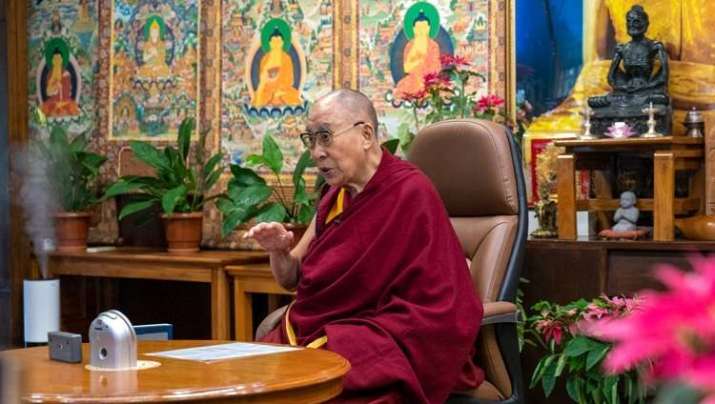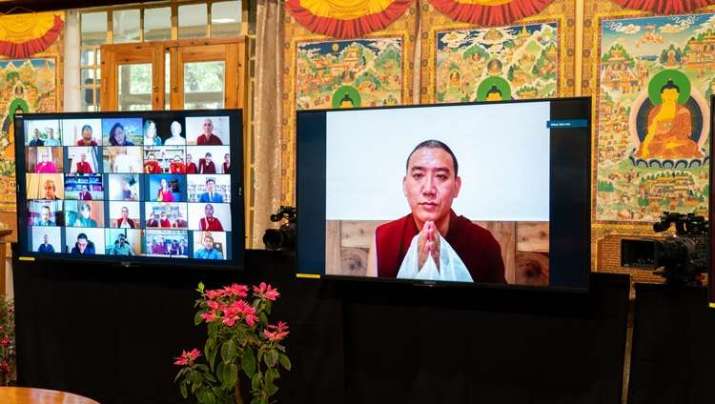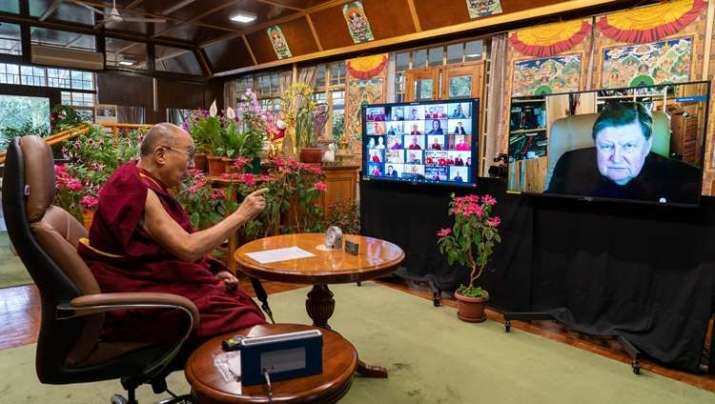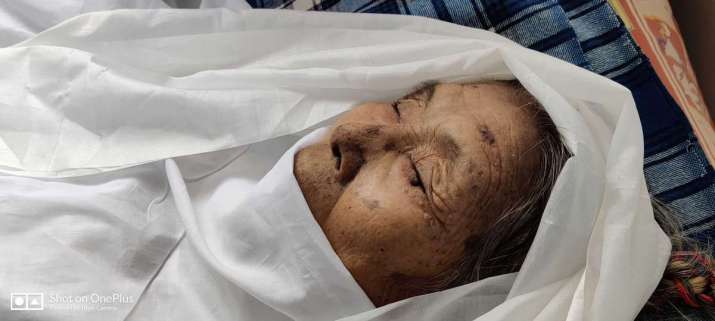NEWS
Dalai Lama Holds Dialogue with Russian Scientists on Research into Buddhist Thukdam Meditation
 His Holiness the Dalai Lama answers questions from Russian scientists. Photo by Ven Tenzin Jamphel. From dalailama.com
His Holiness the Dalai Lama answers questions from Russian scientists. Photo by Ven Tenzin Jamphel. From dalailama.comHis Holiness the Dalai Lama last week conducted an in-depth online dialogue with Russian neuroscientists to discuss their ongoing research into the Buddhist phenomenon and practice of thukdam meditation (Tib: ཐུགས་དམ་).
The term thukdam, derived from the Tibetan words thuk, meaning mind, and dam, meaning samadhi, describes an advanced type of tantric meditation in the Vajrayana tradition practiced by a Buddhist adept during the intermediate or transitional state of death known as bardo. During this period, when biological signs of life have ceased yet the body remains fresh and intact for several days, the master is described as being absorbed in the primordial “clear light stage,” a process of inner dissolution. In 2018, the Dalai Lama initiated a scientific inquiry into the neurophysiological mechanisms of thukdam.
“We need to undertake more research and investigate more cases of thukdam to establish whether the visions are associated with dissolution of the coarser elements,” His Holiness said during the dialogue on 5 May. “Since it is observed that the body of a person going through this process can remain warm, it may be that the dissolution of the earth, water, and fire elements do not coincide with the three visions.” (His Holiness the 14th Dalai Lama of Tibet)
In his widely praised book The Tibetan Book of Living and Dying, the Tibetan Dzogchen teacher Sogyal Lakar explains:
A realized practitioner continues to abide by the recognition of the nature of mind at the moment of death, and awakens into the Ground Luminosity when it manifests. He or she may even remain in that state for a number of days. Some practitioners and masters die sitting upright in that state for a number of days. Some practitioners and masters die sitting upright in meditation posture, and others in the “posture of the sleeping lion.” Besides their perfect poise, there will be other signs that show they are resting in the state of the Ground Luminosity: There is still a certain color and glow in their face, the nose does not sink inward, the skin remains soft and flexible, the body does not become stiff, the eyes are said to keep a soft and compassionate glow, and there is still a warmth at the heart. Great care is taken that the master’s body is not touched, and silence is maintained until he or she has arisen from this state of meditation.
 Lobsang Phuntsok, a monk-researcher from Sera Je Monastery, speaks with His Holiness. Photo by Ven Tenzin Jamphel. From dalailama.com
Lobsang Phuntsok, a monk-researcher from Sera Je Monastery, speaks with His Holiness. Photo by Ven Tenzin Jamphel. From dalailama.comThe participants of the dialogue with His Holiness included monk researchers from Sera Je, Me, Gaden Jangtse, Shartse, Drepung Gomang, Loseling, Tashi Lhunpo, Gyume, and Gyuto Monasteries in India. Also present were Natalia Inozemtseva, deputy director of Save Tibet Foundation, Russia; Prof. Svyatoslav Medvedev of the Russian Academy of Sciences and founder of the Institute of the Human Brain in St. Petersburg; Prof. Alexander Kaplan, head of the Laboratory for Neurophysiology and Neuro-Computer Interfaces at Moscow State University (MSU); Konstantin Anokhin, director of the Institute for Advanced Brain Studies, MSU; Yulia Boitsova, researcher at the Laboratory of Neurovisualization, Institute of Human Brain, St. Petersburg; Geshe Ngawang Norbu of Sera Je Monastery and supervisor of the Russian Science Center; Lobsang Phuntsok, a monk-researcher at Sera Je Monastery; and project coordinator Telo Tulku Rinpoche, the shadjin lama (head lama) of Kalmykia and honorary representative for the Dalai Lama in Russia, Mongolia, and members of the Commonwealth of Independent States.
During the audience with the Dalai Lama, Prof. Medvedev of the Russian Academy of Sciences gave a summery of the research activities of his team.* Through research laboratories in Tibetan settlements in Bylakuppe and Mundgod, in the southwestern Indian state of Karnataka, the neuroscientists have examined 104 monks in meditation and on several occasions have observed senior monastics who are believed to have attained the state of thukdam—including, most recently, a monk who remained in thukdam for 37 days at Gyuto Monastery in Sidhbari, near Dharamsala.
A forensic physician was invited to examine the body of the monk at various stages after death, the Office of His Holiness the Dalai Lama reported, emphasizing that the scientists had demonstrated that the body of a person in thukdam is in a different state from a body undergoing the ordinary process of death.
 The Dalai Lama speaks with Prof. Svyatoslav Medvedev of the Russian Academy of Sciences. Photo by Ven Tenzin Jamphel. From dalailama.com
The Dalai Lama speaks with Prof. Svyatoslav Medvedev of the Russian Academy of Sciences. Photo by Ven Tenzin Jamphel. From dalailama.comThe Dalai Lama explained that in Tibetan Buddhism, it is believes the dying undergo a process of dissolution. Yet after some accomplished tantric meditators cease breathing, the process of dissolution offers three visions, during which 80 different conceptions dissolve—33 during the first vision, 40 during the second, and seven during the final stage near attainment.
“When an ordinary person dies, there is a dissolution of the elements. Buddhists believe that beings go through past and future lives, so there is some bearing on this too,” the Dalai Lama observed. “My own senior tutor, Ling Rinpoche, remained in thukdam for 13 days. Recently, a monk at Gyuto Monastery remained in this state for 37 days. This is an observable reality, which we need to be able to explain. There is evidence to see and measure. We can also find a detailed explanation of the inner subjective experience of the process of death in the Guhyasamaja Tantra texts. I hope scientists can take all this into account and come up with an explanation.” (His Holiness the 14th Dalai Lama of Tibet)
The wide-ranging discussion encompassed a broad spectrum of related topics, among them the functioning of the brain during meditation, emotional and mental well-being, conditions for maintaining peace of mind, rebirth and memories of past lives, and the techniques and characteristics of various tantric meditation practices.
 Ninety-year-old Chokpa Tenzin died in her Bengaluru home in September last year. As the hours passed after her apparent demise, there were no other signs of death. Her body remained supple, without signs of rigor mortis, and her skin remained warm, as if she was in a deep sleep. According to the Tibetan doctor who examined her body, she was in the clear light stage of deep meditation. A week later, her body finally started to show signs of decomposition, indicating that she had exited the state of thukdam. From livemint.com
Ninety-year-old Chokpa Tenzin died in her Bengaluru home in September last year. As the hours passed after her apparent demise, there were no other signs of death. Her body remained supple, without signs of rigor mortis, and her skin remained warm, as if she was in a deep sleep. According to the Tibetan doctor who examined her body, she was in the clear light stage of deep meditation. A week later, her body finally started to show signs of decomposition, indicating that she had exited the state of thukdam. From livemint.comHis Holiness noted that practitioners of thukdam should have be accomplished spiritual practitioners with a deep founding in the three principals of the Buddhist path: the determination to attain liberation, the awakening mind, and an understanding of the intrinsic emptiness of existence. They should also have cultivated a sound tantric practice and be well versed in the three visions and taking the three bodies during bardo.
“Rebirth involves consciousness. Consciousness consists of a continuity of moments of consciousness. Its nature is clarity and awareness,” His Holiness explained. “The minds of all conscious creatures are like this. If we try to find a beginning to consciousness, we come up against the need for it to arise from a compatible cause—that is a previous consciousness. Therefore, we conclude that consciousness has no beginning because its source has to be a previous moment of consciousness.
“Although animals may have more acute sensory perceptions, human beings have sharper intelligence. However, it is mental consciousness that is crucial to both. We talk about past lives on the basis of the continuity of consciousness. Our subtlest consciousness has no beginning and no end. So, the mind goes on life after life until the attainment of buddhahood.” (His Holiness the 14th Dalai Lama of Tibet)
* Buddhist Scholars, Russian Scientists Probe Neurology of Death Meditation (Buddhistdoor Global)
References
Sogyal Rinpoche. 1992. The Tibetan Book of Living and Dying. New York: HarperCollins.
See more
A Scientific Investigation of Meditation by Russian Neuroscientists (His Holiness the 14th Dalai Lama of Tibet)
90-year-old Bengaluru woman in 'thukdam', or post-death meditative state, surprises scientists (Mint Lounge)
Related news reports from Buddhistdoor Global
Senior Tibetan Lama the Third Bardor Tulku Rinpoche Dies Aged 71
Tibetan Buddhist Monk Geshe Jampa Gyatso Reported to Have Attained a State of Thukdam
Tibetan Monk Shows No Signs of Decay 26 Days after Clinical Death
Lhundrub Chime Gatsal Ling Announces Passing of Garje Khamtrul Rinpoche
Buddhist Scholars, Russian Scientists Probe Neurology of Death Meditation
Renowned Sakyapa Teacher His Holiness Dagchen Rinpoche Dies
Related features from Buddhistdoor Global
Welcome to the Bardo
Tibetan Book of the Dead, Part One: Cosmic Jumper
Dances of the Luminous Bardo
The Mahaparinirvana Ceremony of His Holiness Chatral Sangay Dorje Rinpoche














